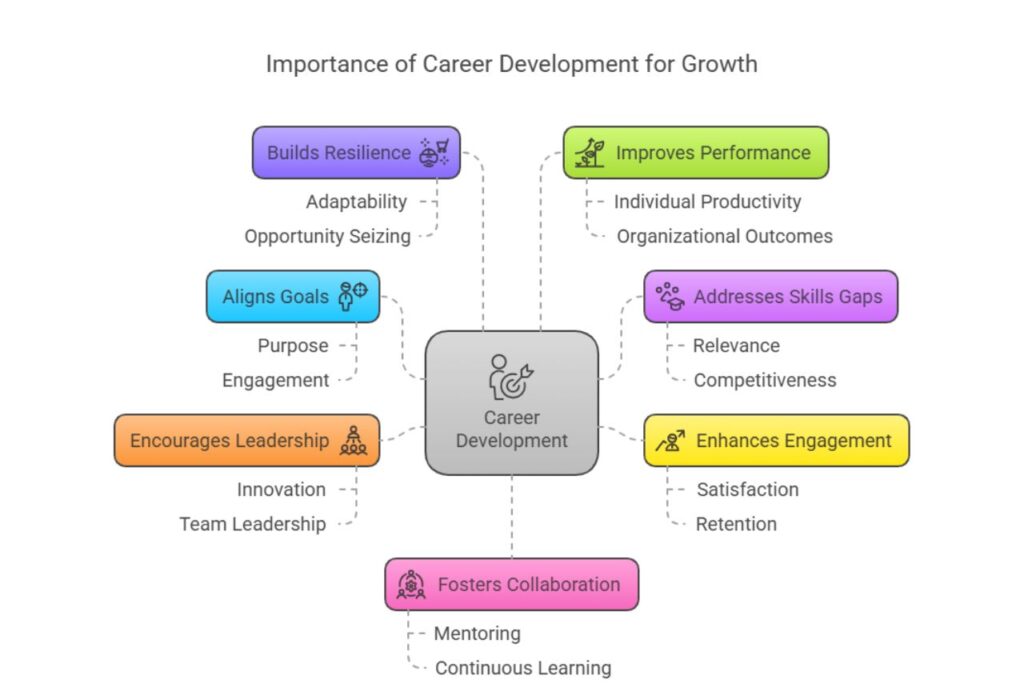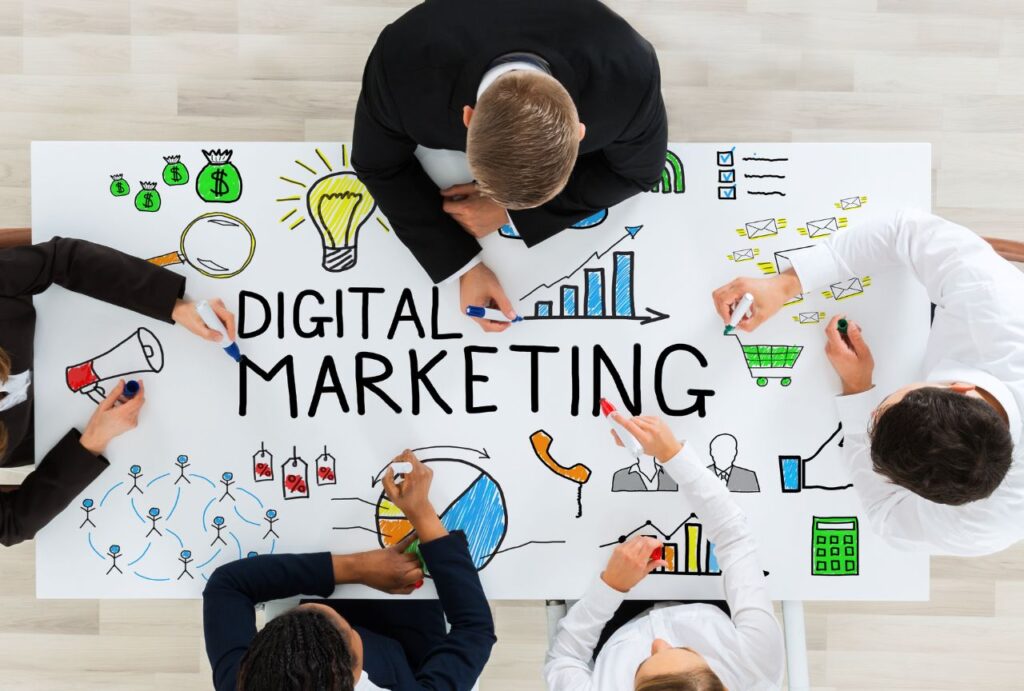Career development programs have become a cornerstone of professional growth, offering employees structured opportunities to build their skills, explore new roles, and advance in their careers. In today’s fast-changing work environment, organizations that prioritize these programs not only strengthen their workforce but also stay competitive in their industries.
These programs go beyond training sessions, encompassing initiatives designed to align personal goals with organizational success. They empower employees to take ownership of their professional journeys while addressing critical business needs such as talent retention, skill enhancement, and leadership development.
I. What Makes Career Development Crucial for Growth?
Career development is a critical driver of both individual and organizational success. As the workplace continues to evolve, professionals and employers alike must prioritize growth strategies that prepare them to adapt, thrive, and excel in their respective fields. Below are key reasons why career development is essential for achieving meaningful progress:
1. Aligns Personal and Organizational Goals
Career development programs create a bridge between an individual’s aspirations and an organization’s objectives. By aligning employee ambitions with company goals, these programs encourage a sense of purpose and engagement. Employees feel valued when their growth is seen as a priority, leading to increased productivity and a stronger connection to their roles.
2. Addresses Skills Gaps and Prepares for the Future
Rapid technological advancements and changing industry demands highlight the importance of staying ahead of the curve. Career development initiatives equip employees with the tools and knowledge required to remain relevant and competitive. By closing skills gaps, organizations not only enhance individual capabilities but also build a more agile and future-ready workforce.
3. Enhances Employee Engagement and Retention
Employees prefer to stay in organizations that invest in their growth. Development opportunities improve job satisfaction, reduce turnover, and create a positive workplace culture. High retention rates benefit organizations by lowering recruitment costs and preserving institutional knowledge.
4. Encourages Leadership and Innovation
Structured career development programs cultivate leaders who can drive innovation and lead teams effectively. Investing in leadership development ensures a pipeline of skilled professionals ready to step into key roles. This helps organizations maintain stability and growth during transitions.
5. Builds Organizational Resilience
Organizations that prioritize career development are better equipped to handle changes in the marketplace. A skilled and adaptable workforce can navigate challenges, seize opportunities, and contribute to long-term success. By empowering employees, companies create a strong foundation for sustained growth.
6. Improves Performance and Productivity
When employees have access to tools, training, and resources that support their growth, their performance improves. Career development programs not only boost individual productivity but also positively impact overall organizational outcomes. Employees equipped with the right skills and knowledge can tackle challenges with confidence and efficiency.
7. Fosters Collaboration and Knowledge Sharing
Career development initiatives often involve mentoring, coaching, and teamwork, which encourage collaboration and the sharing of expertise. These activities strengthen interpersonal relationships within the organization and create a culture of continuous learning and support.

Also Read: 30 Positive Quotes For The Workplace To Uplift You
II. Best 7 Career Development Programs For Real Growth
1. Learning Through Micro-Credentialing
Micro-credentialing involves short, focused training programs that provide employees with specific, in-demand skills. These credentials are often industry-recognized, allowing employees to demonstrate their expertise in targeted areas.
This approach to continuous learning is particularly effective in addressing rapidly changing job requirements. Employees can quickly acquire new skills and apply them in their roles, enhancing their value to the organization.
Example:
IBM’s commitment to micro-credentialing has transformed the way employees learn and grow. Through its “SkillsBuild” program, IBM offers access to short, skill-focused courses that align with both personal career goals and organizational needs.
2. Personalized Career Growth Plans
Personalized career growth plans provide employees with tailored pathways to achieve their professional goals. These plans are designed to consider an individual’s strengths, areas for improvement, and long-term aspirations while aligning them with organizational objectives.
Organizations that implement these plans empower employees to take an active role in shaping their careers, contributing to higher job satisfaction and retention. Regular reviews and updates to these plans ensure they remain relevant to evolving roles and skills.
Example:
PwC has set a benchmark for personalized growth plans through its “My+ Career Experience” initiative. This program enables employees to choose their career paths, offering flexibility and tailored development opportunities to meet unique aspirations.
3. Integrated Job Shadowing Experiences
Job shadowing experiences allow employees to observe and learn directly from colleagues in different roles or departments. These programs are invaluable for gaining insights into day-to-day responsibilities, work processes, and the skills required in specific roles.
Integrated job shadowing experiences help employees understand career pathways within the organization and develop new perspectives that enhance their capabilities. They also encourage collaboration and knowledge transfer across teams.
Example:
Microsoft’s job shadowing program gives employees the opportunity to explore various roles within the company. This initiative fosters a culture of learning and helps individuals identify potential career paths while enhancing their understanding of organizational dynamics.
4. Cross-Functional Collaboration Projects
Cross-functional projects involve teams composed of members from different departments working together to achieve shared goals. These projects provide employees with exposure to diverse skill sets, viewpoints, and challenges, fostering professional growth and innovation.
Such programs enhance problem-solving skills, communication, and adaptability. By collaborating across functions, employees develop a broader understanding of the organization and its operations.
Example:
Google’s “20% Time” initiative encourages employees to dedicate part of their workweek to projects outside their primary roles. This approach has resulted in breakthrough innovations like Gmail and Google Maps, while providing employees with opportunities to develop new skills and expand their impact.
5. Global Mobility and Exchange Programs
Global mobility and exchange programs allow employees to work in different locations, countries, or departments within the organization. These programs expose employees to varied work environments, cultures, and business practices, enriching their professional and personal development.
By participating in these programs, employees gain global perspectives and enhance skills such as cultural competence and adaptability, which are increasingly valuable in today’s interconnected world.
Example:
Deloitte’s “Global Mobility Program” enables employees to work on international assignments, providing them with valuable cross-cultural experiences. These assignments are tailored to align with career goals while contributing to the company’s global objectives.
6. AI-Powered Career Mapping Tools
AI-powered career mapping tools use advanced algorithms to provide personalized career recommendations based on an individual’s skills, interests, and goals. These tools analyze data such as job trends, performance metrics, and industry demands to suggest relevant career paths and growth opportunities.
These tools empower employees to make informed decisions about their professional journeys while enabling organizations to identify and address talent gaps. The technology enhances accessibility and efficiency, making career planning a seamless process.
Example:
Accenture’s “MyCareer” platform leverages AI to deliver customized career guidance to employees. The tool helps individuals explore potential roles, identify skill-building opportunities, and plan their development in alignment with both personal aspirations and organizational needs.
7. Future-Focused Leadership Academies
Leadership academies are designed to prepare employees for leadership roles by providing structured training, practical experience, and skill development. These programs focus on areas such as decision-making, strategic thinking, communication, and team management.
Future-focused academies prioritize equipping employees with the tools needed to lead in dynamic environments. Participants are often exposed to real-world challenges and simulations to develop critical leadership capabilities.
Example:
Procter & Gamble’s “Leadership Academy” exemplifies a forward-thinking approach to leadership development. The academy offers immersive experiences that refine leadership skills and prepare employees to take on influential roles within the organization.
Career development programs are not just initiatives, they are investments in the future of individuals and organizations alike. By implementing strategies that support growth, companies create environments where talent thrives and innovation flourishes. Embracing these programs signals a commitment to excellence and progress, ensuring a workforce that is empowered, skilled, and ready to meet the challenges of tomorrow.



